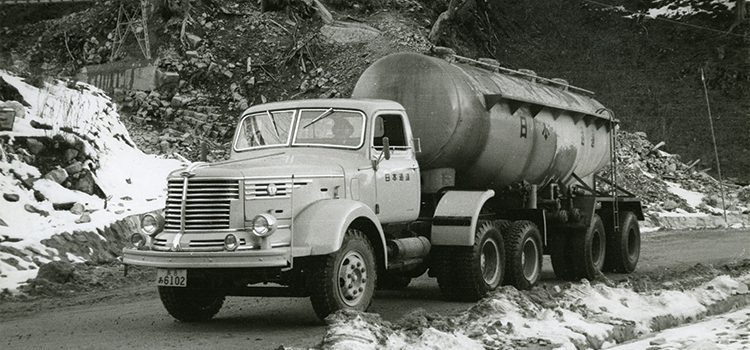Prior to developing the 6TW, the design and development teams faced a dilemma. Was there really sufficient demand in Japan for a 10-ton payload heavy-duty truck considering that most roads were unpaved, even arterial routes?
They were not to be deterred in spite of such uncertainties. The UD engine was extremely robust, even in global terms, providing the leeway to produce a top-performance truck to make maximum use of this capability. Moreover, since the market for heavy-duty trucks didn’t exist in Japan, it was decided that the best course of action was to cultivate the market themselves.
Around that time, reports started to filter in that foreign-made trucks were to be used in the construction of the Kurobe Dam, which was set to be the country’s largest hydroelectric power facility. A huge amount of materials would have to be transported when building a structure of this magnitude. The team believed that such a project would be the ideal place to debut the 6TW and fully expected that it could easily compete with its overseas counterparts in terms of performance and durability. With that in mind, they approached the company consigned with building the dam to test the recently completed 6TW.
The person in charge at the site was not convinced, however. Construction would take place at the headwaters of the Kurobe River where the surrounding mountains climb to 3,000m. If one of the trucks broke down, the project would fall way behind schedule. No Japanese-made vehicle was believed to be able to handle the extremely difficult job.Undaunted, the UD members pointed out the specs of the 6TW and eventually persuaded the construction company to at least test it out for comparison.
Amazed at the results, a company official remarked, “Japan can now produce trucks with performance and reliability rivaling those from abroad.” And with that, the 6TW was officially used in the construction of the Kurobe Dam. The 6TW trucks delivered huge steel beams and a massive amount of cement and other materials to the construction site with minimal breakdowns during the entire period. In this way, UD Trucks played a vital role in one of Japan’s biggest projects to date.
Supporting Japan’s leap forward in logistics
Orders flooded in from all over Japan once news spread of the superb performance and reliability of the 6TW at the Kurobe Dam site. It was also a major hit at a motor show held in Tokyo soon after.
With the 1964 Tokyo Olympics just around the corner, plans were set in motion to construct a variety of infrastructure that ran from high-speed expressways to the ultra-fast “bullet train,” or shinkansen, and high-rise hotels. The 6TW once again proved to be invaluable, transporting construction materials in a diverse array of settings, even the carriages for the shinkansen.

The Tokyo Olympics ushered in an era of rapid economic development for Japan, which came to be known as the “miracle of Asia.” Progress in construction of Japan’s expressways nationwide triggered a rapid shift from an era of rail freight to one of truck transportation. And leading the way was the 6TW. The series had since grown to include the 12-ton payload 6TW12, the 6TW12 dump truck and the 6TW tractor truck, making it perfectly suited to meet high-speed, mass transportation needs in industrial and logistics fields.
